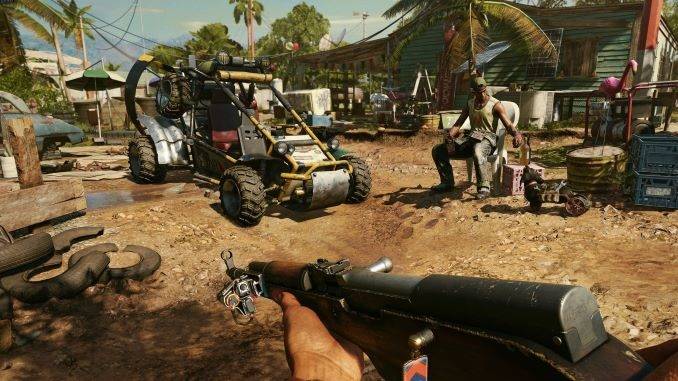
There’s a new Far Cry out. There’s always a new Far Cry out. And even for a business as inherently cynical as entertainment, and as inherently cynical as big budget games, Far Cry is exceptionally cynical. What began as a tech showcase with a last-second, half-baked sci-fi story has become a biennial exercise in repetition, an endless cycle of the same chaos in a different jungle, the same appropriation of a different culture, the same game with just enough changes to give credulous preview writers something to fill their column inches with. Shoot, hunt, run through the jungle, all while trying to undermine a charismatic supervillain crafted out of cliches: it’s as formulaic as a Big Mac.
This year’s model puts you in a fake Cuba that’s also a fake Haiti, complete with a fake dictator played by a fake Latino. The Black and Italian actor Giancarlo Esposito, sleepwalking through his latest calm and collected villain routine, is Antón Castillo, a murderous tyrant who exploits the impoverished people of Yara. You play a guerilla superhero who joins up with the local revolutionaries and immediately becomes their most valued and important member. If you can credit Far Cry with anything other than its mechanically sound and enjoyable action, it’s the fact that the series ditched its white savior fixation after the atrocious Far Cry 3 and started focusing on characters from the countries and cultures found in the games. Dani, your hero here, is a native Yaran, either a man or a woman (your choice), whose goal is liberating the archipelago from under the boot of a cartoon sociopath.
Far Cry 6 is good at what Far Cry games usually do well. The physical and mental processes of playing it often achieve that elusive quality known as “fun.” Staking out an enemy fort, making a plan to sneak in undetected, getting found out halfway through, and successfully shooting your way out of the ensuing disaster accomplishes the bare minimum of what a game like this should accomplish; it can be exciting, it can be thrilling, it can give off a sensation of genuine risk, often followed by fear, frustration, or sometimes both. When you lose yourself in the action of Far Cry, it’s easy to forget all the parts of the game that don’t come together, or that are actively alienating.
Videogames that cost tens of millions of dollars to make typically aren’t a place to look for nuance. This has long been a key problem with Ubisoft games, including Far Cry; it adopts a veneer of real-world relevance for a sense of gravitas, and then stops far short of ever actually grappling with the issues and problems it co-opts. That’s as true as ever with Far Cry 6. The class differences and political backdrop to Yara’s culture are thinly sketched and barely explored, and most of its characters are stereotypes that exist solely to move the plot along. Nothing about Yara feels real, even as the game plays on real life pain and tragedy for an unearned sense of depth. Castillo nicely sums up the hole at the game’s core; despite his cool demeanor, Esposito’s corrupt dictator is as over-the-top in his cruelty as a comic book villain, and as cliched as any number of ‘80s action movie bad guys.
There are three memorable moments when the game approaches saying something before quickly pulling back inside its shell. None of it is especially original or insightful, but it’s still the closest Far Cry has gotten to an actual and intentional political statement since Far Cry 2. First is a moment when the guerilla leader, Clara Garcia, tells Dani that “the American dream doesn’t come in our color,” referring to the hardships faced by immigrants in America. In that same conversation Clara notes the relative futility of their revolution—how it’s just a first step on a long road towards peace and independence, and how there will be at least a generation of civil war and rebellion even after they topple Esposito’s character. Later the game references how capitalism and international business exploits the third world, with a white, North American businessman who will gladly swap sides from working with Castillo to working with the guerillas as long as his supply chain remains flowing. That’s not a lot of substance to work with for a game that lasts this long.
Again, it’s all just so nakedly cynical. Evoking the real suffering of real people for a witless B-movie of a videogame? Asking players to take its story and characters seriously while simultaneously giving them a cockfighting minigame that’s styled after a fighting game? Constantly turning real countries and cultures into cartoons, with a Canadian studio owned by a French company (one that’s rife with harassment and employee abuse) focusing on a different foreign country in peril with every game? Repeating the same basic actions and mechanics, the same gameplay loop, the same fundamental structure, sequel after sequel? Far Cry 6 is no more thoughtful or elevated than the Madden and WWE games that get pumped out almost every single year, no matter how thoroughly it wraps itself up in its paper-thin sociopolitical dress. It’s exasperating how little these games respect their players or the people whose existence they exploit—whether that’s the populations they appropriate or the employees who are overworked in their creation.
There’s a new Far Cry out. There’s always a new Far Cry out. Maybe it’s time for that to stop?
Far Cry 6 was developed and published by Ubisoft. Our review is based on the Xbox Series X version. It is available for PlayStation 5, PlayStation 4, Xbox One, PC, and Stadia.
Senior editor Garrett Martin writes about videogames, comedy, travel, theme parks, wrestling, and anything else that gets in his way. He’s also on Twitter @grmartin.